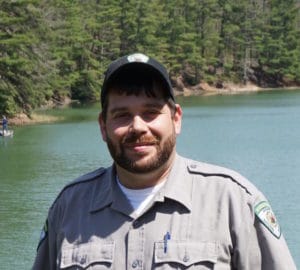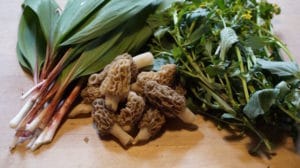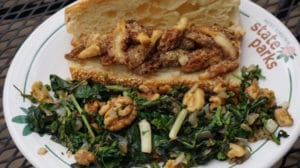The 2019 Wild Edibles Festival is Coming Soon to a State Park Near You
Watoga State Park Naturalist, Chris Bartley, is visibly excited about this year’s Wild Edibles Festival. When I stopped at the park headquarters to talk to him last Thursday, he started off our conversation discussing the major, and likely better, changes to the format of the event. “Instead of scheduled classes this year, we are trying an ‘open forum’ approach. The downside to having people sign up for classes when other classes are being conducted simultaneously is that people have to choose between presentations. Often they are forced to miss other classes they would like to attend. With this change, people can move from demonstration to demonstration and have a full experience. “

Chris said this year’s wild edibles festival event will be held at the picnic shelter.T This spacious area allows attendees to visit demonstrations on various aspects of gathering and utilizing wild edibles, including herbal and medicinal uses. Additionally, several naturalists from other state parks will be on hand to conduct guided wild edible walks.
This year’s Wild Edibles Festival kicks off at 3 PM on Friday, May 3 with a guided foraging hike around Watoga Lake. Those interested should assemble at the Activities Building, bring water, wear closed-toe shoes and clothing appropriate for the weather and water.
At 7 PM Friday Geo Derick, Keynote Speaker, will discuss Wild Medicine: The Art and the Science. Geo is a Registered Clinical Herbalist and is the founding owner, practitioner, and formulator of Geo Joys. Geo enjoys formulating custom medicines for clients that are both good tasting and therapeutic. She is no stranger to our Wild Edibles Festival. And her presentations are always well attended and popular. This presentation takes place in the Activities Building near the pool.
Activities commence at 10 AM Saturday until approximately 4 PM. Visit the many vendors, demonstrations and guided walks throughout the day, all focused on wild foods, drink, and medicines. Sample wild foods. Garlic mustard pesto, ramp pickles and chili will be available. Live music is provided by Sugar Run. Watoga Wild Edibles Festival is fun and educational!
For more information on the Wild Edibles Festival contact Christopher Bartley at (304) 799- 4087 or via email at or Contact Watoga Foundation.
A Short History of Foraging for Wild Foods

The number of people who must forage for their daily sustenance decreases every year. However, some can still be found in some remote areas such as the Amazon River Basin. Agriculture, in existence for about 10,000 years, has replaced virtually all hunting and gathering societies. With the exception of sport hunting and fishing, the knowledge and skills required to procure wild foods and medicines are in danger of being lost in the industrialized world. However, on Native American lands and in Appalachia people have always consumed seasonal plants, berries, nuts, and mushrooms found in nature.
Euell Gibbons came to public attention in 1962 when he wrote best-seller, “Stalking the Wild Asparagus” It is often regarded as the classic of foraging guides. Six more books of the same or similar genre. Mr. Gibbons books were well timed for the “Back to Earth” movement of the ’60s and ’70s. They are appreciated by the growing number of people interested in foraging for wild foods.
Euell Gibbons was also known as spokesman for Post Grape Nuts during this period. His commercials would often start with “Ever eat a pine tree?” “Many parts are edible.” The commercials ended with “the taste of Post Grape Nuts reminds me of wild hickory nuts.” You can see some of these old commercials on YouTube., as well as many funny parodies of Euell. In on he is eating a bowl of Grape Nuts and pauses to say “Of course I don’t usually eat it (Grape Nuts) out of a bowl like this, usually I just eat it out of my shoe. Sometimes I just eat my shoe…”
In the last decade or so there has been a resurgence of interest in collecting wild foods. Some aspects of this pastime have become trendy. Afew years ago upscale restaurants offered such dishes as nettle salad, causing a rush on nettle foraging. Too bad it wasn’t the invasive garlic mustard. Even the term ‘foraging’ has been replaced by ‘wildcrafting’ in many circles. Pocahontas County is thankfully not one of them.
But on the whole the revived interest in wild foods has been a good thing. Bringing attention to environmental concerns such as the damage perpetrated by invasive species, and getting people off their couches and into the outdoors are positive developments. Books on the subject of foraging have become more sophisticated through the years, offering delicious and healthy recipes. An improvement of the standby method of the ’60s which directed foragers to boil everything and then drench it in butter.
Speaking of recipes for wild foods, I set out on a trail last week with the intention of harvesting a handful of ramps and a mess of wintercress, also called creasy greens. I unexpectedly stumbled upon an old apple tree that had a dozen or so morels circling it. On my way back home I gave thought to how I might prepare this trio of wild delicacies.

Dinner that evening consisted of sautéed ramps and creasy greens with roasted walnuts topped with a drizzle of balsamic vinegar reduction. The delicious greens sat alongside a morel po-boy with homemade aioli. This sumptuous plate was paired with a Dogfish Head Watermelon IPA.
That sounded a lot like foodie-speak, didn’t it?
Sorry, I meant to say that I fried up those shrooms and slid em into a bun with a slather of mayo. Then I boiled up those greens, put a stick of butter on em, and washed it all down with a Miller Lite.
Happy Hiking and Foraging,
Ken Springer